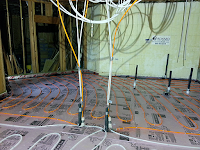Plumbers get more calls to open clogged drains than for any other service. Many such calls could be prevented by greater care in the use of drains. The most-used drain is the one in the kitchen sink and that is the drain most often clogged.
Preventing this situation can be done by carefully watching what is emptied into the sink drain and by the regular use of a safe biodegradable waste digester. Your plumber can give you more information on these products.
Sink stoppages are usually caused by liquid fats, emulsified by warm dishwater and carried through the pipes. The water cools as it proceeds to the main sewer and leaves the fatty deposits along the way. A film of grease forms on the pipe wall, then another and another. Coffee grounds and bits of food add to this accumulation layer until the pipe becomes impassible.
Pour excess grease into a tin can and throw it out with the garbage, not down the sink drain. When using a food disposer, always let sufficient cold water run to carry the particles down and into the main line to prevent buildup in the smaller waste lines.
We offer discounts and special offers - click here. Call our office today at (541) 500-1787.
In the event of a stoppage, you should have a "plumber's friend," or plunger - a large rubber suction cup with a wooden handle. Cup it tightly over the drain and plunge it vigorously several times. If it is a double drain sink, make sure you seal the other drain, so water will not splash out into the other bowl or on you. Drain piping can also be cleaned by removing the J-bend on the trap below the fixture. First place adhesive tape around the packing nut or wrap the wrench jaws with cloth to prevent scratching the metal surface. If plastic piping is in place, do not grip the nuts too tightly with the wrench, as they can crack easily.
Place a bucket directly under the pipe to catch any dripping from the open pipe. Pull out the clogging material with a piece of wire or small hand-turned cable. If you take the trap off, have some new gaskets ready to slip into the joints.
#plumbing #homeimprovement #construction


No comments:
Post a Comment